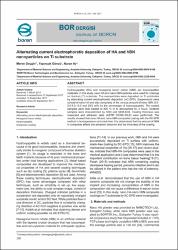| dc.contributor.author | Geçgin, Merve | |
| dc.contributor.author | Göncü, Yapıncak | |
| dc.contributor.author | Ay, Nuran | |
| dc.date.accessioned | 2019-10-22T16:59:26Z | |
| dc.date.available | 2019-10-22T16:59:26Z | |
| dc.date.issued | 2017 | |
| dc.identifier.issn | 2149-9020 | |
| dc.identifier.uri | http://www.trdizin.gov.tr/publication/paper/detail/TWpRek5USTBOQT09 | |
| dc.identifier.uri | https://hdl.handle.net/11421/21856 | |
| dc.description.abstract | Hydroxyapatite (HA) and hexagonal boron nitride (hBN) are biocompatible materials. In this study, nano HA and nano hBN particles were used for coatings on titanium (Ti) substrate. The nanoparticles were deposited on Ti substrates by alternating current electrophoretic deposition (AC-EPD). Suspensions were consist of nano HA and also comprised of the various amount of nano hBN (0.02.0-5.0-10.0 and 25.0 wt% by the percentage of hydroxyapatite). The coated samples were heat treated at 800 oC in Ar atmosphere for 2 hours. Sintered samples were characterized by XRD and SEM-EDS. Coating thickness was measured and adhesion tests (ASTM D3359-09-B) were performed. The results showed that nano HA and nano hBN composite coating with the AC-EPD method is homogeneous and crack free. It is determined that the amount of hBN in composite affects the adhesion behavior and the thickness of the coating. | en_US |
| dc.description.abstract | Hydroxyapatite (HA) and hexagonal boron nitride (hBN) are biocompatible materials. In this study, nano HA and nano hBN particles were used for coatings on titanium (Ti) substrate. The nanoparticles were deposited on Ti substrates by alternating current electrophoretic deposition (AC-EPD). Suspensions were consist of nano HA and also comprised of the various amount of nano hBN (0.02.0-5.0-10.0 and 25.0 wt% by the percentage of hydroxyapatite). The coated samples were heat treated at 800 oC in Ar atmosphere for 2 hours. Sintered samples were characterized by XRD and SEM-EDS. Coating thickness was measured and adhesion tests (ASTM D3359-09-B) were performed. The results showed that nano HA and nano hBN composite coating with the AC-EPD method is homogeneous and crack free. It is determined that the amount of hBN in composite affects the adhesion behavior and the thickness of the coating. | en_US |
| dc.language.iso | eng | en_US |
| dc.rights | info:eu-repo/semantics/openAccess | en_US |
| dc.subject | Mühendislik | en_US |
| dc.subject | Jeoloji | en_US |
| dc.subject | Maden İşletme ve Cevher Hazırlama | en_US |
| dc.title | Alternating current electrophoretic deposition of HA and hBN
nanoparticles on Ti substrate | en_US |
| dc.type | article | en_US |
| dc.relation.journal | BOR DERGİSİ | en_US |
| dc.contributor.department | Anadolu Üniversitesi, Mühendislik Fakültesi, Malzeme Bilimi ve Mühendisliği Bölümü | en_US |
| dc.identifier.volume | 2 | en_US |
| dc.identifier.issue | 2 | en_US |
| dc.identifier.startpage | 102 | en_US |
| dc.identifier.endpage | 109 | en_US |
| dc.relation.publicationcategory | Makale - Ulusal Hakemli Dergi - Kurum Öğretim Elemanı | en_US |


















